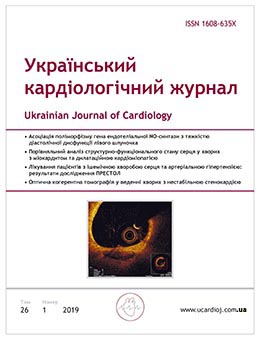Group and individual patients’ training impact on effectiveness of controlling cardiovascular risk factors
Main Article Content
Abstract
The aim – to compare the effectiveness of group versus individual patients’ training of the medical basics to control the essential cardiovascular risk factors.
Materials and methods. The study included 210 patients with high and very high cardiovascular risk. The first group comprised 75 patients who studied in Health Schools «Basics of Healthy Life Style». The second group comprised 75 patients who were offered individual consulting. 60 patients were representatives of the control group. Patients of both experimental groups were examined before the beginning and at the end of the training course. General clinical examination was carried out, anthropometric indicators were identified (body weight, height, body mass index, waist circumference, hip circumference, body build), blood pressure, glucose content, cholesterol and its fractions in blood.
Results and discussion. In both groups of patients reliable reduction of blood pressure values was observed. For example, at the beginning of the study the number of patients with blood pressure target values was 31 persons (41.8 %) among the patients of the first group and 46 persons (60.9 %) among the patients of the second group. In the first group the average indicators of lipid metabolism did not show reliable change. However, in the second group the reliable reduction of total cholesterol by 21.1 % (р=0.031), low density lipoprotein cholesterol by 20.1 % (р=0.04) and the rise of the high-density lipoprotein cholesterol by 11 % (р=0.03) were found. Such behavioral risk factors as smoking, alcohol and table salt consumption did not reliably change in both groups of patients. Physical activities, assessed by the number of steps per day, did not reliably change in the first group 2311.6±1672.4 m steps per day and 2033.33±1980.27 steps per day (р=0.205), but it rose in the second group – from (2346.67±1845.54) m steps at the beginning of the study to 2654.67±1922.08 m at the end of the study (р=0.007). In the first group the life quality indicators, assessed by the data from questionnaires using SF-36 Health Status Survey, did not reliably change (58.66±16.21 and 62.54±16.39, р=0.062), in the second group it rose significantly – from 58.16±9.88 to 67.21±14.34 (р=0.008).
Conclusions. The results of our research demonstrated higher effectiveness of the individual education compared to the group training. Group training of the patients with high and very high cardiovascular risk in the Health Schools «Basics of Healthy Life Style» encourages better control of blood pressure, but it does not significantly influence behavioral risk factors and lipid metabolism indicators in the patients with high and very high cardiovascular risk. Individual training of the patients with high and very high cardiovascular risk leads to significant reduction of blood pressure values, improves lipid metabolism indicators, increases physical activity and enhances life quality indicators.

